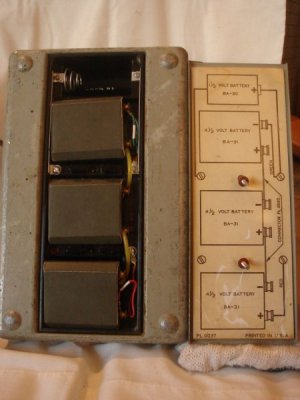- Joined
- Feb 13, 2017
- Messages
- 2,138
Battery "form factors" have been wild until relatively recently. They come from early builders of vacuum tube radios. And model airplane builders. And any number of specialty applications. The recent "standardization" is a God send to me. Recent being since 1967 or so. In those days, odd voltages were profligate, and that on a good day.
The point I came onboard to make has to do with a, I think Triplett, multimeter that dates back to a friend's father working in the shipyards in the '40s. It uses a solid "brick" rated at 4.5 volts for the resistance scale. I replaced that with a "D" cell carrier with three cells. It works fine now, has for twenty years or better.
Also have a fiber optics "OTDR", basically an archaic XT with a ram disk. Hard disks in those days were pretty big, 13 inches or so deep. It also has a three cell keep alive battery, that gets changed whenever I happen to think about it.
Dry cells, carbon-zinc cells, have been around since the git-go of radio. Even the current 9 volt transistor battery is 6 each 1.5 volt dry cells bonded together inside the can. You just made a larger version. Keep up the thinking.
.
The point I came onboard to make has to do with a, I think Triplett, multimeter that dates back to a friend's father working in the shipyards in the '40s. It uses a solid "brick" rated at 4.5 volts for the resistance scale. I replaced that with a "D" cell carrier with three cells. It works fine now, has for twenty years or better.
Also have a fiber optics "OTDR", basically an archaic XT with a ram disk. Hard disks in those days were pretty big, 13 inches or so deep. It also has a three cell keep alive battery, that gets changed whenever I happen to think about it.
Dry cells, carbon-zinc cells, have been around since the git-go of radio. Even the current 9 volt transistor battery is 6 each 1.5 volt dry cells bonded together inside the can. You just made a larger version. Keep up the thinking.
.


